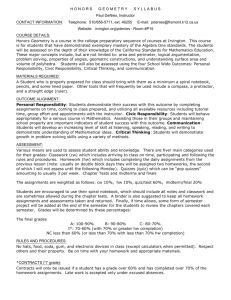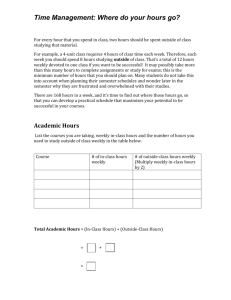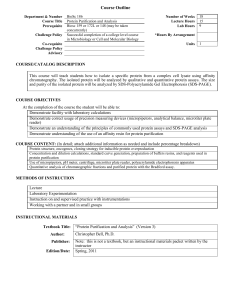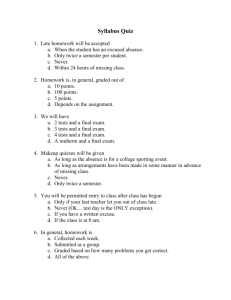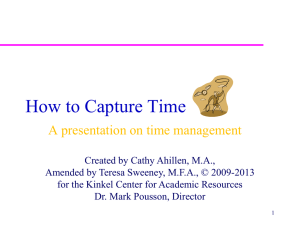ENVIRONMENTAL SCIENCE: Semester Lesson Plan goals and
advertisement
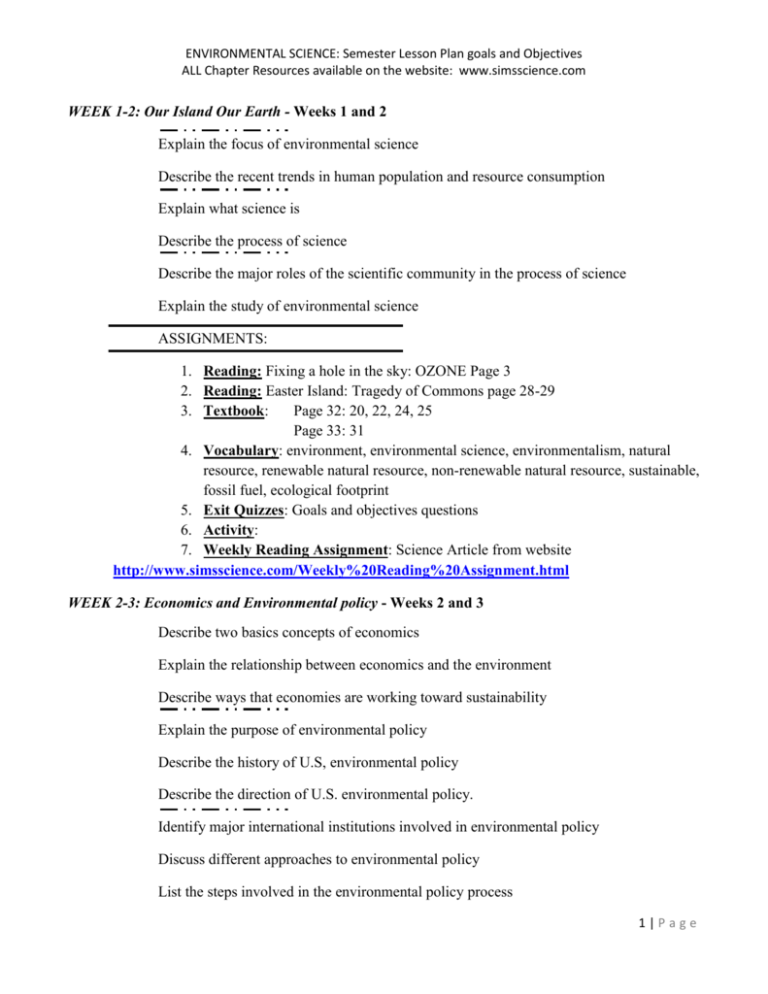
ENVIRONMENTAL SCIENCE: Semester Lesson Plan goals and Objectives ALL Chapter Resources available on the website: www.simsscience.com WEEK 1-2: Our Island Our Earth - Weeks 1 and 2 Explain the focus of environmental science Describe the recent trends in human population and resource consumption Explain what science is Describe the process of science Describe the major roles of the scientific community in the process of science Explain the study of environmental science ASSIGNMENTS: 1. Reading: Fixing a hole in the sky: OZONE Page 3 2. Reading: Easter Island: Tragedy of Commons page 28-29 3. Textbook: Page 32: 20, 22, 24, 25 Page 33: 31 4. Vocabulary: environment, environmental science, environmentalism, natural resource, renewable natural resource, non-renewable natural resource, sustainable, fossil fuel, ecological footprint 5. Exit Quizzes: Goals and objectives questions 6. Activity: 7. Weekly Reading Assignment: Science Article from website http://www.simsscience.com/Weekly%20Reading%20Assignment.html WEEK 2-3: Economics and Environmental policy - Weeks 2 and 3 Describe two basics concepts of economics Explain the relationship between economics and the environment Describe ways that economies are working toward sustainability Explain the purpose of environmental policy Describe the history of U.S, environmental policy Describe the direction of U.S. environmental policy. Identify major international institutions involved in environmental policy Discuss different approaches to environmental policy List the steps involved in the environmental policy process 1|Page ENVIRONMENTAL SCIENCE: Semester Lesson Plan goals and Objectives ALL Chapter Resources available on the website: www.simsscience.com ASSIGNMENTS: 1. Reading: Cleaning the Tides of Tijuana: Ocean Pollution Page 35 2. Reading: Fighting for clean water: Ocean Pollution page 56-57 3. Textbook: Page 60: 16-21 Page 61: 28-29 4. Vocabulary: economics, supply, demand, cost benefit analysis, ecological economics. Non-market value, market failure, eco-labeling 5. Exit Quizzes: Goals and objectives questions 6. Activity: 7. Weekly Reading Assignment: Science Article from website http://www.simsscience.com/Weekly%20Reading%20Assignment.html WEEK 4: Earth’s Environmental Systems – Differentiate among an atom, element, molecule and a compound Discuss how various macromolecules are essential to life Identify some unusual properties of water Describe two major ways that earth’s systems interact Define Earth’s geosphere, lithosphere, hydrosphere, asthenosphere and atmosphere Explain how the law of conservation of matter applies to the behavior of nutrients in the environment Describe the carbon cycle Describe the events of the phosphorus cycle Explain the importance of bacteria to the nitrogen cycle ASSIGNMENTS: 1. Reading: Gulf of Mexico Dead Zone: Hypoxia Page 63 2. Reading: Nutrients: Deeper Research on one page 90-91 3. Textbook: Page 94: 19-26 Page 95: 32-33 4. Vocabulary: feedback loop, erosion, geosphere, lithosphere, biosphere, atmosphere, hydrosphere, evaporation, transpiration, precipitation, condensation, aquifer, groundwater, law of conservation of matter, nutrient, biogeochemical cycle, primary producer, photosynthesis, consumer, decomposer, cellular respiration, eutrophication, nitrogen fixation 2|Page ENVIRONMENTAL SCIENCE: Semester Lesson Plan goals and Objectives ALL Chapter Resources available on the website: www.simsscience.com 5. Exit Quizzes: Goals and objectives questions 6. Activity: 7. Weekly Reading Assignment: Science Article from website http://www.simsscience.com/Weekly%20Reading%20Assignment.html WEEK 5-6: Ecology - Weeks 5 and 6 Describe the different levels of organization studied by ecologists Explain the difference between biotic and abiotic factors Discuss how an organism’s habitat relates to its survival Describe the factors that influence a population’s growth rate Explain exponential growth and logistic growth Explain how limiting factors and biotic potential affect population growth ASSIGNMENTS: 1. Reading: Costa Rican Cloud Forest: Environmental conditions Page 99 2. Reading: Cloudless forest: Extinction of Golden Toad page 118-119 3. Textbook: Page 122: 17-21, 23, 25, 26 Page 123: 28-30 4. Vocabulary: ecology, species, population, community, ecosystem, biosphere, biotic factor, abiotic factor, habitat, resource, population size, population density, population distribution, age structure, age structure diagram, sex ratio, survivorship curve, immigration, emigration, migration, exponential growth curve, limiting factor, carrying capacity, logistic growth, density-dependent factor, density independent factor, biotic potential 5. Exit Quizzes: Goals and objectives questions 6. Activity: 7. Weekly Reading Assignment: Science Article from website http://www.simsscience.com/Weekly%20Reading%20Assignment.html WEEK 7-9: Evolution and Community Ecology Weeks 7, 8 and 9 Describe the four primary mechanisms of biological evolution Describe how speciation and extinction affect the diversity of life on Earth Discuss the factors that influence an organism’s niche Compare and contrast predation, parasitism and herbivory 3|Page ENVIRONMENTAL SCIENCE: Semester Lesson Plan goals and Objectives ALL Chapter Resources available on the website: www.simsscience.com Describe mutualism and commensalism Explain the difference between consumer and producer Explain the effect of inefficient energy transfer on community structure Describe how feeding relationships can have both direct and indirect effects on community members Describe what happens to a community after a disturbance Explain the conditions necessary for a species to become invasive ASSIGNMENTS: 1. Reading: Zebra Mussels: Invasive Species Page 125 2. Reading: Dodo and Tambalacoque seeds: Mutualism page 156-157 3. Textbook: Page 160: 17-22, 23, 25, 26 Page 161: 29-32 4. Vocabulary: evolution, tolerance, resource partitioning, predation, coevolution, parasitism, symbiosis, herbivory, mutualism, commensalism, primary producer, photosynthesis, chemosynthesis, consumer, cellular respiration, herbivore, carnivore, omnivore, detritivore, decomposer, trophic level, biomass, food chain, food web, keystone species 5. Exit Quizzes: Goals and objectives questions 6. Activity: 7. Weekly Reading Assignment: Science Article from website http://www.simsscience.com/Weekly%20Reading%20Assignment.html Biomes and Aquatic systems Mid-term Project: PowerPoint presentation of biome: see web page http://www.simsscience.com/biomesproject.html WEEK 10: Biomes and Aquatic Ecosystems Week 10 Explain how biomes are characterized Describe how net primary production varies among biomes Explain how organisms are adapted to the conditions of their biomes 4|Page ENVIRONMENTAL SCIENCE: Semester Lesson Plan goals and Objectives ALL Chapter Resources available on the website: www.simsscience.com Describe the criteria ecologist use to classify aquatic systems List the major categories of freshwater ecosystems Explain the ecological importance of estuaries List the three major zones of the ocean ASSIGNMENTS: 8. Reading: Too much of a good thing: Biomes and Ecosystems Page 163 9. Reading: Elephant Culling: Poaching Ivory page 192-193 10. Textbook: Page 196: 17-22, 26 Page 197: 28-29 11. Vocabulary: Biome, Climate, weather, climatograph, net primary production, salinity, photic zone, upwelling, estuary, floodplain 12. Exit Quizzes: Goals and objectives questions 13. Activity: 14. Weekly Reading Assignment: Science Article from website http://www.simsscience.com/Weekly%20Reading%20Assignment.html WEEK 11: Biodiversity and Conservation – Week 11 Differentiate the components of biodiversity Explain two ways in which biodiversity varies across groups or geography Describe the economic benefit of biodiversity Describe how biodiversity is monitored and explain current biodiversity trends List the major causes of biodiversity loss Explain legal actions nations can take to protect biodiversity Explain the goal of species survival plans Describe three strategies for managing whole ecosystems and habitats ASSIGNMENTS: 15. Reading: Saving the Siberian tiger: Biodiversity Page 199 16. Reading: California Condors: Species Comebacks page 218-219 17. Textbook: Page 222: 17-20 Page 223: 21-26, 30 5|Page ENVIRONMENTAL SCIENCE: Semester Lesson Plan goals and Objectives ALL Chapter Resources available on the website: www.simsscience.com 18. Vocabulary: biodiversity, species diversity, genetic diversity, ecosystem diversity, extirpation, endangered species, threatened species, habitat fragmentation, poaching, endangered species act, captive breeding, species survival plan, biodiversity hotspot, endemic 1. Exit Quizzes: Goals and objectives questions 2. Activity: 3. Weekly Reading Assignment: Science Article from website http://www.simsscience.com/Weekly%20Reading%20Assignment.html WEEK 12: Human Population - Week 12 Describe how technological advances have contributed to human population growth Explain recent trends in population growth Identify characteristics of human population that are studied by demographers Describe the fertility rates and replacement fertility Explain how the age structure and sex ratio of a population define its potential for growth Describe the demographic transition Discuss social factors that affect population growth Describe how human impact their environments Discuss the negative and positive impacts of technology ASSIGNMENTS: 1. Reading: Chinas one child policy: population Page 227 2. Reading: United states Census: Accurate population data page 248-249 3. Textbook: Page 252: 18-25 Page 263: 33-34 4. Vocabulary: Industrial Revolution, infant mortality rate, life expectancy, growth rate, demography, total fertility rate, replacement fertility rate, demographic transition 5. Exit Quizzes: Goals and objectives questions 6. Activity: 7. Weekly Reading Assignment: Science Article from website http://www.simsscience.com/Weekly%20Reading%20Assignment.html 6|Page ENVIRONMENTAL SCIENCE: Semester Lesson Plan goals and Objectives ALL Chapter Resources available on the website: www.simsscience.com WEEK 13: Water Resources - Week 13 Discuss how freshwater can be both renewable and limited Explain the significance of a watershed Explain how most groundwater is accessed List the three primary categories of freshwater use Relate the causes of surface water depletion to their effects Explain the major causes and effects of groundwater depletion Describe strategies for addressing water depletion Discuss the main categories of water pollution Explain why groundwater pollution is difficult to clean up Discuss the sources and effects of major pollutants found in the ocean Describe how water is regulated and treated ASSIGNMENTS: 1. Reading: Looking for water in the desert: Running out of water Page 419 2. Reading: Wastewater treatment: Arcata Marsh and Sanctuary page 444-445 3. Textbook: Page 448: 18-25, 26, 27 Page 449: 30-33 4. Vocabulary: fresh water, surface water, runoff, river system, watershed, groundwater, permeable, impermeable, aquifer, water table, recharge zone, well, water diversion, dam, reservoir, salinization, desalinization, xeriscaping, pointsource pollution, non-point source pollution, cultural eutrophication, wastewater, algal bloom, pathogen, red tide, septic system 5. Exit Quizzes: Goals and objectives questions 6. Activity: 7. Weekly Reading Assignment: Science Article from website http://www.simsscience.com/Weekly%20Reading%20Assignment.html WEEK 14: The Atmosphere - Week 14 Describe the properties of the atmosphere 7|Page ENVIRONMENTAL SCIENCE: Semester Lesson Plan goals and Objectives ALL Chapter Resources available on the website: www.simsscience.com Identify the four main layers of the atmosphere Explain heat transfer and the interaction of air masses in the troposphere Explain how both natural processes and human activities can cause air pollution Describe how air pollutants affect human health Explain what causes smog and how temperature inversions affect it and other forms of pollution Explain how acid deposition occurs and describe its effects Explain how the provisions of the Clean Air Act have reduced air pollution in the United states Describe the international efforts to reduce the ozone hole ASSIGNMENTS: 1. Reading: Charging for Clean air in London: Pollution Charge Page 451 2. Reading: Clean air act: Acid Rain page 474-475 3. Textbook: Page 478: 17-24, 25, 27, 28 Page 479: 32-36 4. Vocabulary: atmosphere, relative humidity, air pressure, troposphere, stratosphere, ozone layer, mesosphere, thermosphere, radiation, conduction, convection, convection current, air mass, front, air pollution, emission, fossil fuel, primary air pollution, secondary air pollution, smog, temperature inversion, acid deposition 5. Exit Quizzes: Goals and objectives questions 6. Activity: 7. Weekly Reading Assignment: Science Article from website http://www.simsscience.com/Weekly%20Reading%20Assignment.html Chapter 16: Global Climate Change Week 15 Describe the factors that affect how the sun warms the earth Discuss the role of wind patterns in determining climate Explain how the oceans affect climate Describe how climate is affected by topography, volcanos, regional vegetation and periodic changes in the Earth’s orbit 8|Page ENVIRONMENTAL SCIENCE: Semester Lesson Plan goals and Objectives ALL Chapter Resources available on the website: www.simsscience.com Identify evidence of global warming Explain three methods used to study climate change State the probable cause of global climate change State the ways in which the warming atmosphere affects ecosystems and organisms Explain how climate change is affecting people now Predict future effects of climate change on people List ways to reduce greenhouse gases related to the use and generation of electricity Describe some of the ways of reducing greenhouse gases related to transportation Describe other strategies for reducing greenhouse gases Explain how nations are working together to try to address climate change ASSIGNMENTS: 1. Reading: Maldives islands: Sea Level rise Page 483 2. Reading: Climate Clues in Ice: EPICA Ice core page 508-509 3. Textbook: Page 511: 17-24 Page 512: 33-36 4. Vocabulary: greenhouse effect, greenhouse gas, thermohaline circulation, El Nino, topography, global climate change, global warming, proxy indicator, climate model, fossil fuel, coral bleaching, carbon footprint, carbon tax, carbon offset, carbon sequestration, Kyoto Protocol 5. Exit Quizzes: Goals and objectives questions 6. Activity: 7. Weekly Reading Assignment: Science Article from website http://www.simsscience.com/Weekly%20Reading%20Assignment.html Chapter 17: Non-Renewable Energy Week 16 Define energy and differentiate between kinetic and potential energy Identify different forms of energy Describe how human society uses energy resources Explain how fossil fuels formed Describe the uses of coal and how it is removed from the ground 9|Page ENVIRONMENTAL SCIENCE: Semester Lesson Plan goals and Objectives ALL Chapter Resources available on the website: www.simsscience.com Describe the uses of oil and how it is extracted Explain the characteristics and uses of natural gas Predict the future of fossil fuels Explain how pollutants released by fossil fuels damage health and the environment Describe the environmental and health effects of mining and drilling Explain the implications of dependence on foreign nations for fossil fuels Explain why energy conservation is important Relate nuclear fission to the production of energy Describe how a nuclear power plant generates electricity Identify the advantages and disadvantages of nuclear power Contrast nuclear fusion with nuclear fission and explain the issues related to nuclear fusion ASSIGNMENTS: 1. Reading: Oil or Wilderness: Energy Solutions environmental sacrifice Page 515 2. Reading: Using Coal to generate Electricity: Clean coal technology page 542-543 3. Textbook: Page 546: 19-26, 29, 30, 31 Page 547: 33-36 4. Vocabulary: energy, kinetic energy, potential energy, combustion, energy efficiency, renewable energy, nonrenewable energy, electricity, strip mining, subsurface mining, petroleum, petrochemical, oil sands, methane hydrate, acid drainage, energy conservation, nuclear energy, nuclear fusion, nuclear fission, nuclear reactor, meltdown, nuclear waste 5. Exit Quizzes: Goals and objectives questions 6. Activity: 7. Weekly Reading Assignment: Science Article from website http://www.simsscience.com/Weekly%20Reading%20Assignment.html Chapter 18: Renewable Energy Week 17 Explain the benefits and current status of renewable energy resources Define biomass energy and explain how it is used Describe how geothermal energy is harnessed and used 10 | P a g e ENVIRONMENTAL SCIENCE: Semester Lesson Plan goals and Objectives ALL Chapter Resources available on the website: www.simsscience.com Explain how river water can be used to generate electricity Identify benefits and costs of hydropower Describe how energy from the ocean can generate electricity Describe techniques for using solar energy to heat buildings and generate electricity Analyze the benefits and costs of solar energy Explain how wind energy can be used to produce electricity Analyze the costs and benefits of wind energy Describe how hydrogen fuel can be produced Explain the way fuel cells work and how they are used ASSIGNMENTS: 1. Reading: Germany’s big Bet on Renewable energy: Page 549 2. Reading: Biofuels page 574-575 3. Textbook: Page 578: 17-25 Page 579: 31-34 4. Vocabulary: biomass energy, biofuel, biopower, geothermal energy, ground source heat pump, hydropower, tidal energy, ocean thermal energy conservation, passive solar heating, active solar heating, flat plate solar heating, photovoltaic cell (PV), concentrating solar power (CSP), wind turbine, wind farm, electrolysis, fuel cell 5. Exit Quizzes: Goals and objectives questions 6. Activity: 7. Weekly Reading Assignment: Science Article from website http://www.simsscience.com/Weekly%20Reading%20Assignment.html Renewable Energy Project: Final Project: PowerPoint presentation of biome: see web page http://www.simsscience.com/renewable%20energy%20project.htm 11 | P a g e


